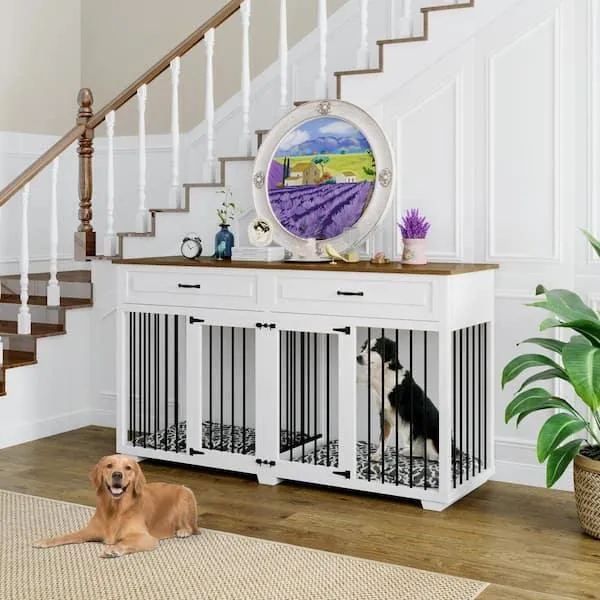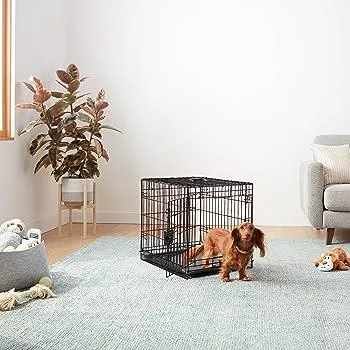Everything You Need to Know About Dog Shipping Crates
If you’re thinking about transporting your furry friend by plane, ship, or long car rides, a quality dog shipping crate is a must-have. As any pet owner knows, keeping dogs safe and comfortable during travel is a top priority. In this article, I’ll cover all the basics of dog shipping crates from sizing to safety to tips from my own experiences flying with dogs. By the end, you’ll have the knowledge to choose the right crate and prepare your pup for smooth sailing.
Choosing the Right Size Crate
Proper sizing is crucial so your dog isn’t crammed in or able to turn around. As a general rule, choose a crate that allows your dog to both sit and stand comfortably while only having enough extra room to turn around with ease. Measure your dog from nose to tail, then add 3-6 inches to the length. For the width, add 2-4 inches to the widest point of your dog’s chest or hips. This will ensure they have breathing space without feeling constrained. You may need to try different sized crates to get the perfect fit for your dog.
- Extra small: Suitable for toy breed dogs up to 10 lbs.
- Small: Appropriate for dogs 10-20 lbs.
- Medium: Best for dogs 20-40 lbs.
- Large: Accommodates dogs 40-70 lbs.
- Extra large: Roomy enough for dogs 70+ lbs.
Material Matters
The two main materials for dog crates are plastic and soft-sided fabric. Plastic crates are durable, easy to clean, and provide sturdy protection. However, they tend to be heavier and more expensive. Soft-sided crates fold up for compact storage and come in varied designs, but may not withstand heavy-duty use over time. For long car trips or shipping on planes or boats, I recommend plastic for its ruggedness. Fabric crates work well for shorter car rides where durability isn’t as crucial of a factor.
Comfort and Safety Amenities
look for crates with the following features to keep your pup protected and content:

- Padded sides – Reduce stress on joints from leaning or bumping during travel.
- Ventilation – Ensure proper airflow. Front, top, and sides are best.
- Lockable door – Transport safely without risk of escape.
- Handles – Makes transporting the full crate easy.
- Collapsible – Easy to store when not in use.
- Rubber feet – Prevent crate from sliding on flat surfaces like in a vehicle.
- Dividers – Adjust crate size as your dog grows.
From my experience flying with dogs numerous times, the most important things are padding, ventilation, and a secure door. An anxious pup can get itself into trouble without these essential protections.
Training Your Dog to Love Their Crate
Even with the perfect crate, trauma from travel can occur if your dog isn’t fully crate trained prior. I always recommend taking time to acclimate your pup to their new crate at home, introducing it as a happy place rather than a carrier of anxiety. Some helpful tips include:
- Feed them meals inside the crate to form positive associations.
- Toss high-value treats into the crate to entice exploration.
- Praise and reward heavily whenever they enter on their own accord.
- Start with just closing the door briefly when they seem calm, then work up to longer periods.
- Place an article of your clothing inside for familiar scents during travel.
Dogs pick up on our energy, so it’s important to remain cheerful and relaxed during crate training. With time and positive reinforcement, they’ll learn to see it as their safe space no matter where the crate may end up.
Make the Travel Experience as Low-Stress as Possible
On moving day, be sure to do everything possible to minimize fear or uncertainty for your pup. Here are some tips:

- Use calming treats, oils, or toys before and during the journey.
- Bring water that doesn’t spill for long trips.
- “Potty” them before leaving so there’s less need for stops.
- Sit near them if traveling in a vehicle to reassure with your presence.
- Cover the crate for confident dogs or use an open crate in the car.
- Avoid excess stimulation like loud music that heightens anxiety.
- Talk to them calmly and gently throughout to let them know it’s safe.
Following these preparations essentially turns their crate into a “happy place” no matter where it may end up. With patience and care, even timid pups can learn to handle travel with ease over time. Let me know if you have any other specific questions!
Real-Life Success Stories
As someone who has flown coast-to-coast with rescue dogs, I can say with confidence that proper crate training and planning makes all the difference. Here’s a success story:
Once I had a miniature schnauzer named Piper who was deathly afraid of loud noises and new situations. It took weeks of gentle desensitization, but she came to love her crate and view it as a safe space. On moving day, I loaded up the car putting Piper securely in her crate with a favorite toy. She snoozed the whole eight hours! When we arrived, she calmly exited happy to see her familiar bed waiting inside. With patience, any dog can overcome fears through positive association.
In conclusion, choosing the right sized crate, training your dog properly, and minimizing stress during travel will give your furry friend the best possible experience. Don’t forget to stop andstretch your legs too! Safe travels to you and your pup. Let me know if you have any other questions.

Factors to Consider When Choosing a Dog Shipping Crate
| Crate Size | Dog Size |
|---|---|
| Small | Toy or small dog under 20 lbs |
| Medium | Medium dog 20-50 lbs |
| Large | Large dog 50-80 lbs |
| Extra Large | Giant dog over 80 lbs |
| Material | Benefits |
| Plastic or Wire | Ventilated, light, easy to clean |
| Soft-Sided | Comfortable, portable |
| Door Location | Access |
| Front-Opening | Easy for loading and viewing dog |
| Top-Opening | More space-efficient for vehicle |
FAQ
-
What size dog shipping crate should I get?
The size of crate you choose depends on the size of your dog. Basically, your pup needs enough room to comfortably stand up, turn around, and lie down. A crate that’s too big can encourage potty accidents, while one that’s too small could be uncomfortable. Measure your pup and check crate size recommendations.
-
How do I introduce my dog to their new crate?
You want your pup’s first crate experience to be positive. To start, feed them meals inside the open crate with the door on. Kind of slowly close the door when they’re eating. Reward calm behavior with treats. Eventually, they’ll think the crate is an amazing place! Be patient, some dogs take longer than others to get used to it.
-
Should I leave my dog in their crate while I’m gone?
It’s generally not recommended to keep your pup crated for too long without breaks. Puppies especially should not be left crated for over 3-4 hours at a time. Adults can usually hold it longer. But is that fair to your furry friend? See if they’re okay with an exercise pen or baby gate enclosed area with toys when you’re away if full freedom isn’t an option yet.
-
What else do I need for my dog’s new crate?
Make sure to provide a cozy blanket and favorite toy or two in the crate. This basically makes it feel more like a den. Don’t use the crate for punishment either. It needs to be a joyful place! You might also want to get a crate pad or liner to protect the floor from accidents at first. Always remove soiled items immediately.

On the other hand, many dogs do end up loving their crates like a safe, quiet place to rest. But perhaps it depends a lot on the individual dog and how much positive training and association you build with the crate from the start. There’s no question that crates used correctly can be an awesome tool. However, it’s crucial not to leave puppies for too lengthy periods by themselves. Nevertheless, it appears most experts recommend not crating for more than 3-4 hours at a stretch for young dogs.
What if my dog hates being in their crate?
If your puppy sort of acts fearful or stressed about the crate, you might backtrack a bit in training. Maybe try feeding just outside the crate at first to quietly build up positive feelings. It could also help showing treats and favorite toys through the bars when locked inside at first. Don’t force it. Rushing this process may lead to issues further down the road. You want the crate experience to be a blast for your buddy!
Are there any tricks to crate training?
Funny enough, I remember one dog trainer said to teach the command “kennel” when putting your pup in their crate. This associates the word with something positive rather than just saying “go to your crate.” I’m not sure if that like really makes a difference or it was just a trick, but hey it can’t hurt to try! Being extra diligent with rewards and praise at first may also help them realize how amazing crates are. Are there any other crate pro tips you amazing animal lovers have? Let me know!
